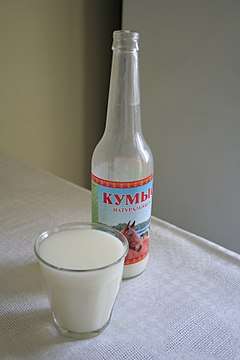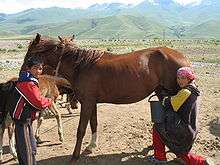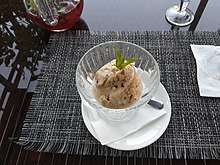Kumis
Kumis (also spelled kumiss or koumiss or kumys, see other transliterations and cognate words below under terminology and etymology - Kazakh: қымыз, qymyz) is a fermented dairy product traditionally made from mare's milk or donkey milk. The drink remains important to the peoples of the Central Asian steppes, of Huno-Bulgar, Turkic and Mongol origin: Kazakhs, Bashkirs, Kalmyks, Kyrgyz, Mongols, and Yakuts.[1] Kumis was historically consumed by the Khitan, Jurchen, and Han Chinese of North China as well.[2]
 A bottle and glass of kumis | |
| Type | Dairy product |
|---|---|
| Main ingredients | Mare's milk |
Kumis is a dairy product similar to kefir, but is produced from a liquid starter culture, in contrast to the solid kefir "grains". Because mare's milk contains more sugars than cow's or goat's milk, when fermented, kumis has a higher, though still mild, alcohol content compared to kefir.
Even in the areas of the world where kumis is popular today, mare's milk remains a very limited commodity. Industrial-scale production, therefore, generally uses cow's milk, which is richer in fat and protein, but lower in lactose than the milk from a horse. Before fermentation, the cow's milk is fortified in one of several ways. Sucrose may be added to allow a comparable fermentation. Another technique adds modified whey to better approximate the composition of mare's milk.[3]
Terminology and etymology
| Look up koumiss in Wiktionary, the free dictionary. |
Kumis comes from the Turkic word kımız.[lower-roman 1][4] Kurmann derives the word from the name of the Kumyks, one of many Turkic peoples,[5] although this appears to be a purely speculative claim. Clauson notes that kımız is found throughout the Turkic language family, and cites the 11th-century appearance of the word in Dīwān Lughāt al-Turk written by Kaşgarlı Mahmud in the Karakhanid language.[6]
In Mongolia, the drink is called airag (Mongolian: айраг [ˈai̯rəɡ])[7] or, in some areas, tsegee. William of Rubruck in his travels calls the drink cosmos and describes its preparation among the Mongols.[8]
Production of mare's milk

A 1982 source reported 230,000 mares were kept in the Soviet Union specifically for producing milk to make into kumis.[9] Rinchingiin Indra, writing about Mongolian dairying, says "it takes considerable skill to milk a mare" and describes the technique: the milker kneels on one knee, with a pail propped on the other, steadied by a string tied to an arm. One arm is wrapped behind the mare's rear leg and the other in front. A foal starts the milk flow and is pulled away by another person, but left touching the mare's side during the entire process.[10]
In Mongolia, the milking season for horses traditionally runs between mid-June and early October. During one season, a mare produces approximately 1,000 to 1,200 litres of milk, of which about half is left to the foals.[11]
Production of kumis

Kumis is made by fermenting raw unpasteurized mare's milk over the course of hours or days, often while stirring or churning. (The physical agitation has similarities to making butter). During the fermentation, lactobacilli bacteria acidify the milk, and yeasts turn it into a carbonated and mildly alcoholic drink.
Traditionally, this fermentation took place in horse-hide containers, which might be left on the top of a yurt and turned over on occasion, or strapped to a saddle and joggled around over the course of a day's riding. Today, a wooden vat or plastic barrel may be used in place of the leather container.[12]
In modern controlled production, the initial fermentation takes two to five hours at a temperature of around 27 °C (81 °F); this may be followed by a cooler aging period.[13] The finished product contains between 0.7 and 2.5% alcohol.[14]
Kumis itself has a very low level of alcohol, comparable to small beer, the common drink of medieval Europe that also helps to avoid the consumption of potentially contaminated water. Kumis can, however, be strengthened through freeze distillation, a technique Central Asian nomads are reported to have employed.[15] It can also be made into the distilled beverage known as araka or arkhi.[16]
History
.pdf.jpg)
Archaeological investigations of the Botai culture of ancient Kazakhstan have revealed traces of milk in bowls from the site of Botai, suggesting the domestication of the animal.[17] No specific evidence for its fermentation has yet been found, but considering the location of the Botai culture and the nutritional properties of mare's milk, the possibility is high.
Kumis is an ancient beverage. Herodotus, in his 5th-century BC Histories, describes the Scythians processing of mare's milk:
Now the Scythians blind all their slaves, to use them in preparing their milk. The plan they follow is to thrust tubes made of bone, not unlike our musical pipes, up the vulva of the mare, and then to blow into the tubes with their mouths, some milking while the others blow. They say that they do this because when the veins of the animal are full of air, the udder is forced down. The milk thus obtained is poured into deep wooden casks, about which the blind slaves are placed, and then the milk is stirred round. That which rises to the top is drawn off, and considered the best part; the under portion is of less account.[18]
This is widely believed to be the first description of ancient kumis-making.[5] Apart from the idiosyncratic method of mare-milking,[19] it matches up well enough with later accounts, such as this one given by 13th-century traveller William of Rubruck:
This cosmos, which is mare's milk, is made in this wise. […] When they have got together a great quantity of milk, which is as sweet as cow's as long as it is fresh, they pour it into a big skin or bottle, and they set to churning it with a stick […] and when they have beaten it sharply it begins to boil up like new wine and to sour or ferment, and they continue to churn it until they have extracted the butter. Then they taste it, and when it is mildly pungent, they drink it. It is pungent on the tongue like rapé wine when drunk, and when a man has finished drinking, it leaves a taste of milk of almonds on the tongue, and it makes the inner man most joyful and also intoxicates weak heads, and greatly provokes urine.[20]
Rubruk also mentions that the Mongols prized a particular variety of black kumiss called caracosmos, which was made specifically from the milk of black mares.
In the 19th century, "kumyss" was used to treat gastrointestinal disorders.[21]
Consumption

Strictly speaking, kumis is in its own category of alcoholic drinks because it is made neither from fruit nor from grain. Technically, it is closer to wine than to beer because the fermentation occurs directly from sugars, as in wine (usually from fruit), as opposed to from starches (usually from grain) converted to sugars by mashing, as in beer. But in terms of experience and traditional manner of consumption, it is much more comparable to beer. It is even milder in alcoholic content than beer. It is arguably the region’s beer equivalent.
Kumis is very light in body compared to most dairy drinks. It has a unique, slightly sour flavor with a bite from the mild alcoholic content. The exact flavor is greatly variable between different producers.
Kumis is usually served cold or chilled. Traditionally it is sipped out of small, handle-less, bowl-shaped cups or saucers, called piyala. The serving of it is an essential part of Kyrgyz hospitality on the jayloo or high pasture, where they keep their herds of animals (horse, cattle, and sheep) during the summer phase of transhumance.
Cultural role
During the Yuan Dynasty of China, kumis was essentially made to be the replacement of tea. Furthermore, Möngke Khan had a drinking fountain made in the Mongol Empire's capital of Karakorum, including kumis alongside Chinese rice wine, Scandinavian mead and Persian grape wine as a symbol of the empire's diversity and size.[22]
The capital of Kyrgyzstan, Bishkek, is named after the paddle used to churn the fermenting milk, showing the importance of the drink in the national culture.
The famous Russian writer Leo Tolstoy in A Confession spoke of running away from his troubled life by drinking kumis.[23]
The Russian composer Alexander Scriabin was recommended a kumis diet and "water cure" by his doctor in his twenties, for his nervous condition and right-hand injury.
The Japanese soft drink Calpis models its flavor after the taste of kumis.[24]
See also
| Wikimedia Commons has media related to Kymyz. |
Notes
References
- Zeder, Melinda A. ed. (2006). Documenting Domestication: New Genetic and Archaeological Paradigms. University of California Press. p. .264. ISBN 0-520-24638-1.CS1 maint: extra text: authors list (link)
- Anderson (1988), p. 80.
- Law p. 121.
- "Kumiss - Define Kumiss at Dictionary.com". Dictionary.com.
- Kurmann, Joseph A.; et al. (1992). Encyclopedia of Fermented Fresh Milk Products. Springer. p. 174. ISBN 0-442-00869-4.
- Clauson, Gerard (1972). An Etymological Dictionary of Pre-Thirteenth-Century Turkish (1st ed.). Oxford: Clarendon Press. p. 629.
- "Airag - Fermented Mare's Milk - Mongolian Beverage".
- The spelling in William's manuscripts varies, and the most recent editor, P. Chiesa, prefers "comos". See Guglielmo di Rubruk, Viaggio in Mongolia (Itinerarium), a cura di Paolo Chiesa, Milano, Fondazione Lorenzo Valla, Mondadori, 2011.
- Steinkraus, Keith H. ed (1995). Handbook of Indigenous Fermented Foods. Marcel Dekker. p. 304. ISBN 0-8247-9352-8.CS1 maint: extra text: authors list (link)
- Indra, Rinchingiin (2003). "Mongolian Dairy Products". In Dendev Badarch, Raymond A Zilinskas (ed.). Mongolia Today: Science, Culture, Environment and Development. Routledge. p. 74. ISBN 0-7007-1598-3.
- Indra p. 73.
- Mischler and Sosorbaram (2005–2006). Ayrag. Mongolian Food Info. Retrieved 11 September 2006.
- McGee, Harold (2004). On Food and Cooking (Revised Edition). Scribner. p. 46. ISBN 0-684-80001-2.
- Law, B A ed. (1997). Microbiology and Biochemistry of Cheese and Fermented Milk. Springer. pp. 120. ISBN 0-7514-0346-6.CS1 maint: extra text: authors list (link)
- McGee p. 761
- "Mongol Arkhi - Milk Liquor - Beverage from Mongolia".
- Outram, A. K.; Stear, N. A.; Bendrey, R.; Olsen, S.; Kasparov, A.; Zaibert, V.; Thorpe, N.; Evershed, R. P. (6 March 2009). "The Earliest Horse Harnessing and Milking". Science. 323 (5919): 1332–1335. doi:10.1126/science.1168594. PMID 19265018.
- Histories, book four. Translation by George Rawlinson; available online at The Internet Classics Archive.
- Sheridan, Paul (2015-05-30). "How to Make Kumis the Scythian Way". Anecdotes from Antiquity. Retrieved 2015-08-27.
- Rockhill, William, translator (1900). The Journey of William of Rubruck to the Eastern Parts of the World, 1253–55. p. 67. London: Hakluyt Society.
- Brush, EF (1882). Kumyss. New York: Tremain & Co.
- Standage, Tom (16 May 2006). "5". A history of the world in 6 glasses. Walker & Co. p. 182. ISBN 978-0802715524. Retrieved 20 December 2019.
- "Tolstoy, Leo – Confession".; Transliterated as "kumys".
- "Story of "CALPIS"". Calpis. Retrieved 30 December 2014.
